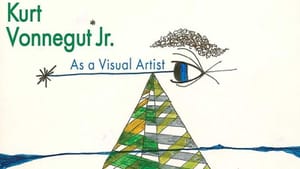Stay in the Loop
BSR publishes on a weekly schedule, with an email newsletter every Wednesday and Thursday morning. There’s no paywall, and subscribing is always free.
When words fail, draw
Drexel University’s Paul Peck Alumni Center Gallery presents Kurt Vonnegut Jr. as a Visual Artist

When Kurt Vonnegut grew weary of writing, he drew—and not just to illustrate novels such as Breakfast of Champions (1973). A new exhibition at Drexel University, Kurt Vonnegut Jr. as a Visual Artist, explores a new view of a famed author.
The exhibition’s substance comes from the private collection of Drexel Law alumna Heather Rose, who was already an enthusiastic reader when she discovered that Vonnegut made drawings separate from his books.
“I was fascinated that I had known so much about him for so long—I thought—and didn’t know this aspect,” she explained in a conversation with Lynn Clouser Waddell, Drexel’s executive director of collections and exhibitions. To complement the exhibit, Rose commissioned nine monumental banners of Vonnegut drawings to hang in the Free Library of Philadelphia’s Parkway Central branch. Drexel and the Free Library are hosting events during the exhibit’s run.
A prolific satirist
Vonnegut (1922-2007) is one of the most influential authors of the 20th century. Over 50 years, he created short stories, plays, essays, and 14 novels featuring a cast of recurring characters and interwoven narratives based on personal experience. Sharply satiric, he took on sacrosanct topics and accepted wisdom, skewering war, government, religion, business, technology, life, and death. He rendered fantastical, tragic plots with glimmers of sardonic humor that can make readers laugh out loud.
The celebrated author once confided to his daughter Nanette that the constant expectation of hitting literary home runs was hard. Drawing was his release. In Fates Worse Than Death (1991), he wrote, “The making of pictures is to writing what laughing gas is to the Asian influenza.”
“A way to make your soul grow”
The drawings, mostly undated and untitled, haven’t been seen in decades, if ever. Though not linked to narratives, there are echoes of Vonnegut’s illustrations. Long, curving visages, seen from the side, often with a single large eye, its gaze indicated by an arrow-straight line. There are pyramidal forms, grids, and patches of color. Text in the gallery describes the style perfectly as blending the movement of Alexander Calder, the whimsy of Joan Miró, and the elongated, melancholy faces of Amedeo Modigliani.
In addition to sketching Vonnegut’s biography, the walls ring with his words, particularly A Man Without A Country (2005), a semi-autobiographical essay collection. It’s as if he’s at your elbow explaining his practice: “The arts are not a way to make a living. They are a very human way of making life more bearable. Practicing an art, no matter how well or badly, is a way to make your soul grow, for heaven’s sake.”
Described as a humanist and an atheist, Vonnegut believed in decency for its own sake, rather than as postmortem insurance. He’d experienced the worst of life early, from his parents’ being overwhelmed by the Depression to his horrifying experiences in World War II. Vonnegut left Cornell in 1943 to serve. By 1945, he was a prisoner of war, confined in a subterranean meat locker in Dresden, Germany, as the Allies firebombed the city into oblivion. After the battle, his German captors brought the prisoners up to an unrecognizable world to begin gathering and burying the more than 130,000 civilian casualties. The experience resulted in the novel Slaughterhouse 5 (1969), considered Vonnegut’s masterwork.
Signs and symbols
Though Vonnegut wasn’t a believer, religion was clearly something he pondered. Basin, recto (n.d.), unlike most work here, is representational and contextual, a baptismal font in a stone niche, with a gold disk hovering above. Another drawing, untitled and undated, depicts a hilltop with three empty, T-shaped crucifixes. Next to each, Vonnegut inscribed “hirst,” defined as a barren, unproductive plot of ground.
Several images are marker-on-paper originals. The ragged edge of one shows where it was torn from a spiral-bound sketchbook. Other works are reproduction prints by Joe Petro III, Vonnegut’s longtime friend and collaborator. One of these, Self Portrait #1 (1993), shows the artist from the side, with a cloud of curls, bushy eyebrows, and a brushy mustache. He looks for all the world like another satiric observer of the American scene, Mark Twain.
We’ve been here before
By bringing Vonnegut forward now, into a time much like the one in which he was so prolific, sending those who know him back to his writing, and bringing others to it for the first time, the exhibition is both reassuring and relevant. We’ve been here—or at least, somewhere like here—before, and pessimistic though he was, even Vonnegut could not completely abandon hope:
“There is no reason why good cannot triumph as often as evil. The triumph of anything is a matter of organization. If there are such things as angels, I hope that they are organized along the lines of the Mafia.”
What, When, Where
Kurt Vonnegut Jr. as a Visual Artist. Through July 19, 2025, at Drexel University’s Paul Peck Alumni Center Gallery, 3142 Market Street, Philadelphia. (215) 895-2000 or drexel.edu.
Accessibility
The Paul Peck Alumni Center’s main entrance (on Market Street) has a set of steps. An wheelchair-accessible entrance is located at the rear of the building, on Perelman Plaza. Visitors can ring the bell for staff assistance to enter and access the elevator.
Sign up for our newsletter
All of the week's new articles, all in one place. Sign up for the free weekly BSR newsletters, and don't miss a conversation.
